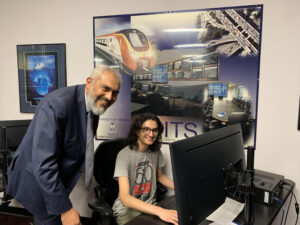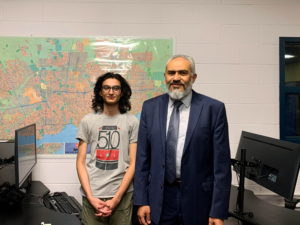Undergrad summer student research positions explored
The following is part of a series introducing CivMin’s undergraduate summer students to the Department and our greater community.
We explore the students’ projects, motivation and challenges, while providing insights into who they are, and what motivates them, beyond academia. It also highlights the multitude of ways summer research opportunities are approached and implemented under the guidance of our industry-leading CivMin professors.

Rohan Wongkee (CivE, Year 3) has a talent for data analysis and a strong interest in the transportation research area. This summer, he’ll be exploring train delays and their impact on passengers within Toronto’s public transportation system, under the supervision of Professor Amer Shalaby. As a frequent TTC user himself, Rohan experiences these delays firsthand. His research will be contributing to improving overall user experience on public transportation.
Tell us a bit about yourself.
Rohan Wongkee: I’m in Civil Engineering and am going into my third year. I’m from the city.
What will be your role this summer and where? What types of tasks and work will you be doing? What’s the research goal?
Rohan: I’ve been looking into train delays on the subway; in the last year, specifically. Now, I’m moving into understanding how these train delays impact passenger delays in the system. The city has an open data portal where there’s plenty of information, including train delay data. We’re also working with BAI Communications, which has access to subway Wi-Fi data, which can be used to approximate passenger volume and such.
We can generally determine how long people are at a station based on their Wi-Fi connection. We’re working on piecing this information together with original destination data for better planning. For example, in the event of a delay, what response should be needed at a given time, in each place.
What motivated you to work with Prof. Shalaby on this project?
Rohan: I’ve always been interested in transit and think I want to [pursue a career in] it once I finish university. I like the work. It’s quite interesting to learn about these things as I get to experience them happening. Whenever delays happen, you want to know why and if it’s best to go one way or another, and it’s hard to tell.
The challenging part is once you have the data, and need to interpret what it means.
What do you foresee being your greatest challenge?
Rohan: A lot of the data structures I’m working with aren’t always the easiest to work with. The hardest part is trying to crack the first step, from where everything else follows. Once you get the ball rolling, it all starts rolling, but you must get it rolling downhill first.
The challenge is the interpretation; the extraction part isn’t hard. The Wi-Fi data has been worked with before, so it’s in a nice structure and easier to work with. The train delay data hasn’t been worked with, but it wasn’t a difficult task to get everything sorted out. The difficult part is once you have the data, and need to interpret what it means.
Have you found any favourite spots on campus?
Rohan: Up on St. George, just north of the Sidney Smith Hall, there’s a little naturalized pocket of forest which is nice to look at and walk through.
Is there anything I haven’t asked you about you’d like to speak on? Final thoughts?
Rohan: The research is fun. Students should look into topics of interest to them.
Do you have any interesting hobbies or talents you’d like to share?
Rohan: I have been taking piano lessons since I was in kindergarten. It’s practically been the singular extracurricular activity I’ve had time for during the semester. The other thing I’ve been doing is stewardship with the Toronto Nature Stewards; they have a lot of sites around the city. It’s a double-edged sword. It’s nice because you’re helping to restore nature, but you also see all these bad plants and can’t always remove them. People wouldn’t want me pulling plants out of their gardens, for example.
Questions for Prof. Shalaby:
What do you hope for Rohan to achieve this summer? Any major takeaways?
Professor Amer Shalaby: Rohan started the summer expressing a very strong interest in public transit and working with data. I had Rohan in one of my classes, CME263 – Probability Theory for Civil and Mineral Engineers, so I knew he was capable of handling large volumes of data and analyzing them. It was an incredibly good fit – [Rohan] has the background knowledge and skills to work with data and is also interested in the type of data we work with, public transit data.
I’m hoping for Rohan’s interests to flourish and strengthen by the end of the summer, and hopefully, this will lead to a future career in public transit. What I do here at U of T’s Transit Analytics Lab is conduct research in transit planning and operations and train the next generation of public transit researchers and practitioners. We’d like to see solutions generated, but also, we help train people who will move on to work in the transit industry. That’s what I’m hoping for Rohan.
To predict people’s behaviour, we need to understand it first.
How will Rohan be contributing to this project/your research?
Prof. Shalaby: Rohan works within the Transit Analytics Lab, a lab concerned with using data to improve the planning, management and operations of public transit systems. One of the topics we’re interested in is transit delays, and we’ve been fortunate to have access to Wi-Fi data in the subway system. Rohan works specifically on subway delays, trying to understand the delays and its impacts on the system’s performance and user experience. Once we achieve this understanding, we can build sophisticated machine-learning models to predict how the system will perform and what people will do when a severe disruption happens.
To predict people’s behaviour, we need to understand it first. Rohan is working towards helping us gain a better understanding of the user experience. Then, hopefully, the models built based on such understanding could be used by transit agencies to predict what people will do when subway services are disrupted. If the models tell us people will wait for shuttle buses, for example, we can then determine how and where shuttle buses should be dispatched. These are the kinds of insights transit agencies can use to formulate their policies.
Is there anything I haven’t asked you about you’d like to speak on? Final thoughts?
Prof. Shalaby: I’ve had students working with me nearly every year. I’ve had undergraduate students from Civil Engineering and Engineering Science. It’s been an incredibly positive experience for my lab and the students. I’ve seen many of them move on to do graduate studies or work in the industry. Someone who worked with me just last year doing his fourth-year thesis, Peter Lai [EngSci 2T3], is starting a new job soon with the TTC. It’s quite satisfying to see how students take their experiences, move on and apply them in the real world.
Do you have any interesting hobbies or talents you’d like to share?
Prof. Shalaby: I’m an avid squash player. I was a student here at U of T and I played for the varsity team for several years. I’ve been active in playing squash since I was 13 years old.
